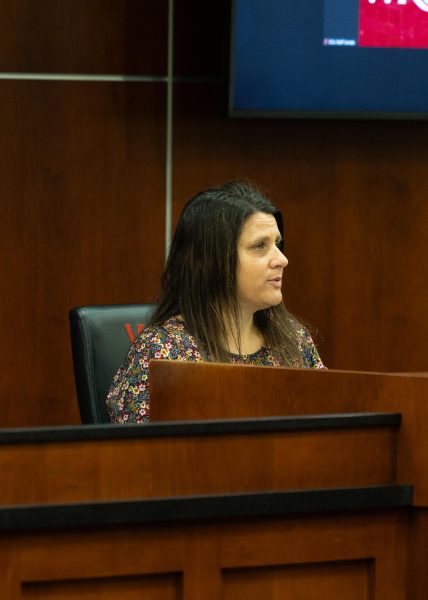Kentucky’s student loan debt continues to climb
February 26, 2019
Kentucky is continuing to face decade-long challenges to its higher education, including an increase in average student loan debt and a decrease in state funding per student.
These challenges resemble a national trend in increasing student loan debt.
The average student loan debt of students from Kentucky’s public and private universities increased by nearly 100 percent from $14,250 in 2004 to $28,447 in 2017.
In 2017, 64 percent of students also graduated with debt compared to 52 percent in 2004, according to information provided by the Kentucky Council on Postsecondary Education.
Aaron Thompson, president of the Kentucky CPE, said more than a decade of budget cuts to Kentucky’s higher education in favor of funding
Kentucky’s Medicaid expansion and pensions has placed a strain on the state’s budget.
“This trend has become the most concerning to us,” Thompson said. “We’re at a breaking point now. If we don’t get more funding into higher education in Kentucky, it will start hurting the quality of education for our students.”
Nigel Taylor, a senior from Winnetka, Illinois, is one of many college students at WKU who has taken out student loans. Taylor, who is a finance, international business and Arabic major, said he has had to take out between $28,000 and $32,000 in student loans.
Although his student loans have not impacted him yet, Taylor said he knows he will need to think about them later when making other financial decisions. He said Kentucky’s increasing amount of student loan debt makes sense because tuition has increased, but he said living expenses are overlooked when people think of the uses of student loans.
“It’s complicated, because I’m not sure what they could do more to fix the situation,” Taylor said, referring to Kentucky’s student loan debt. “I feel like it’s about on par with other states.”
Lillian Smith, a senior from New Albany, Indiana, said she has taken out student loans to pay for college even though WKU was the most affordable university option for her. Although her parents have helped her pay for half of her schooling, Smith said she has still taken out about $45,000 in subsidized and unsubsidized federal loans to pay for WKU.
A first-generation college student, Smith said she has to work full time on top of attending classes in order to pay for college. Smith described living with student loans as having “constant pressure” on her to pass her classes and graduate on time, which she said has caused her to lose sleep.
“It really puts it into perspective as a student when you have to take out loans and you haven’t really decided what you want to do with your life,” Smith said. “It puts a lot of pressure in various parts of your life.”
Kentucky is not the only state facing an increase in student loan debt. Nationally, in 2017, about 65 percent of college seniors who graduated from public and private colleges had student loan debt, borrowing an average of about $29,000, according to the Institute for College Access and Success.
Kentucky is one of just five states in the country that cut higher education funding in the 2018-19 fiscal year, according to the Courier-Journal.
As Kentucky’s student loan debt has increased, students have also become more responsible for paying for Kentucky’s colleges than the state. In 1998-99, state funding made up 67 percent of Kentucky’s college budgets, and tuition and fees made up just 33 percent.
In 2016-17, state funding made up 33 percent of Kentucky’s college budgets, and tuition and fees made up 67 percent, a 50 percent increase.
If changes are not made, the responsibility of paying for Kentucky’s colleges is expected to fall further on students and their tuition and fees. In 2021-22, student tuition and fees are expected to make up 73 percent of Kentucky’s college budgets compared to just 27 percent for state funding, according to the Kentucky CPE.
There has been a $487 million decrease in the amount of state funding per student at Kentucky’s public colleges over the past decade. In 2007-08, state funding per student totaled $9,233, and the amount decreased to $5,941 per student in 2017-18.
For WKU, state appropriations to its operating budgets have decreased about 9.5 percent within the past decade. In the 2018-19 operating budget, state appropriations made up only 19 percent, or $74.4 million. In 2008-09, state appropriations made up about 25 percent of the budget, or $82.3 million, according to WKU’s 2008-09 executive budget summary.
Kentucky’s out-of-pocket costs are also trending higher. For universities like WKU, Eastern Kentucky University and Northern Kentucky University, in 2016-17, the average price of a first-time, full-time in-state undergraduate student totaled $11,246 compared to $9,790 in 2010-11, a nearly 15 percent increase
The University of Kentucky and the University of Louisville have seen a 45 percent increase between 2010-11 and 2016-17, according to the Kentucky CPE.
In an effort toward affordability, Kentucky’s state-funded student financial aid programs are higher per capita. In 2016-17, the total grant dollars per undergraduate student enrollment was $1,317, the fifth highest in the nation.
New Athens, Illinois, sophomore Cassie Crabtree attended WKU because she loved the campus, and she was eligible to receive nearly half of the out-of-state tuition rate as part of WKU’s Tuition Incentive Program. Crabtree, a nursing major, has taken out between $15,000 and $20,000 in student loans to attend WKU, and her parents also help her pay for college.
Crabtree said without her student loans, she would not have been able to attend WKU because of affordability. “It concerns me, because I can either live at home and pay them off while living with my parents, or I could go off on my own, pay for an apartment and work on paying them off that way,” Crabtree said. “They make me consider, ‘How do I want to start off after I graduate?’”
The average amount of student financial aid has also increased in Kentucky’s public colleges over the past decade for Pell and federal grants, state grants and campus-funded grants and scholarships given to a full-time student.
Since 2008, the Kentucky CPE’s tuition and fee policy has set caps on tuition increases to keep them under control. College boards then self-select tuition increases that fall under the caps. In determining rates, the Kentucky CPE takes several factors into account such as faculty salaries, pensions and benefits, building maintenance and student services.
Before these tuition ceilings, the average annual growth rate of tuition across Kentucky’s public colleges was 11.7 percent from 2002-03 to 2008-09. Some significant tuition percent increases in Kentucky’s public colleges between those years included a 15.4 percent in 2003-04 and a 16 percent increase in 2004-05, according to the Kentucky CPE.
After the policy’s implementation, the average annual tuition growth rate from 2009-10 to 2018-19 was 4.5 percent.
Thompson recommended Kentucky colleges continue to be transparent in the costs involved with getting a degree and work on cost-effective measures.
“There’s nothing wrong with borrowing money,” Thompson said. “Student loans are a long-term investment for your education, but student loans can also become a weight around your neck for the rest of your life.”
Ann Mead, WKU’s vice president for finance and administration, said she thought the Kentucky CPE’s information delivered the message that funding postsecondary education is a shared responsibility between students and the state.
“For a variety of reasons, the Commonwealth of Kentucky hasn’t upheld its commitment to shared funding,” Mead said in an email. “Financial pressures such as the unfunded liability for pension obligations make it extremely difficult to fund postsecondary education adequately. We will continue to do all we can to control costs and increased institutional financial aid.”
Bowling Green junior Alisha Mayberry said she has taken out some student loans, although she did not know how much. Mayberry, a music major, said she probably would not have been able to afford college if she could not have taken out student loans.
“It’s not surprising,” Mayberry said, referring to Kentucky’s increased student loan debt. “I figured it was going to happen eventually.”
Mayberry said she believes the increased rates of tuition, housing and other fees play a role in the increased amount of student loan debt.
“I’m not looking forward to paying all that back after I graduate, but getting an education is worth it,” Mayberry said.
News reporter Nicole Ziege can be reached at 270-745-6011 and [email protected]. Follow her on Twitter at @NicoleZiege.
























